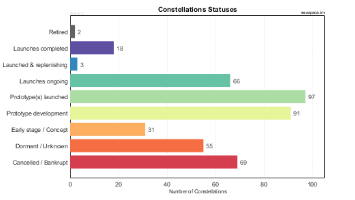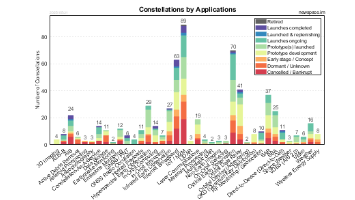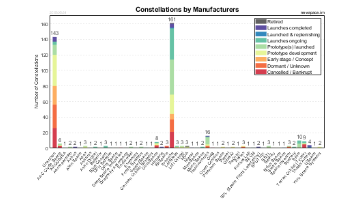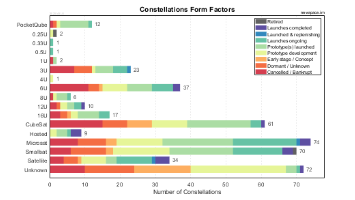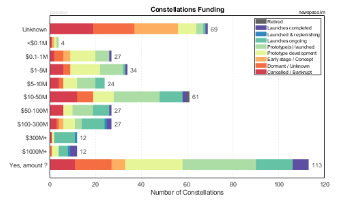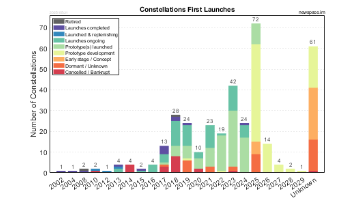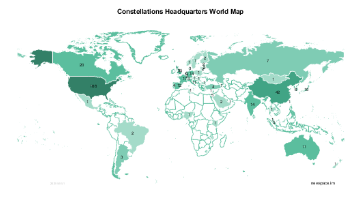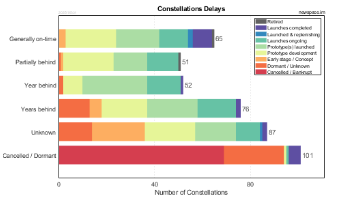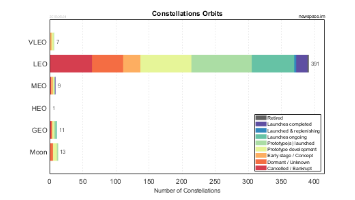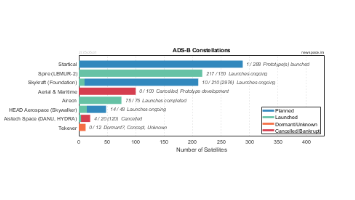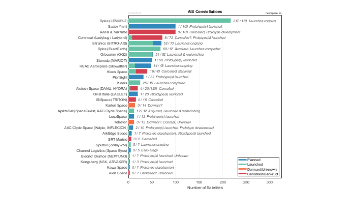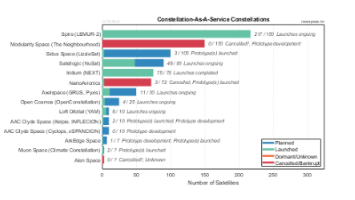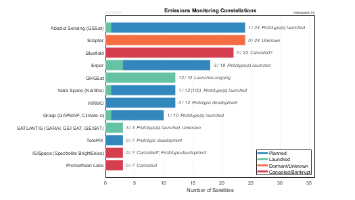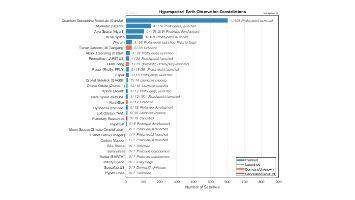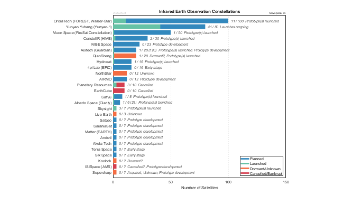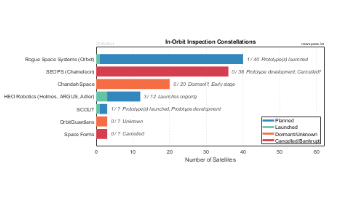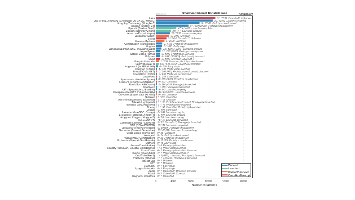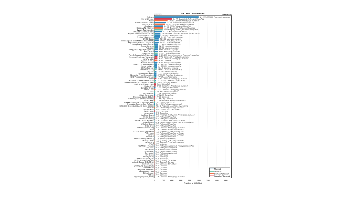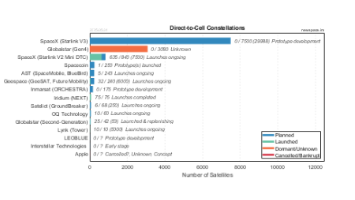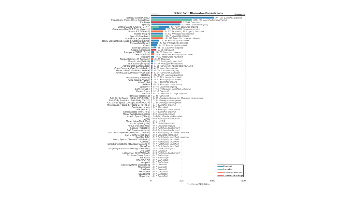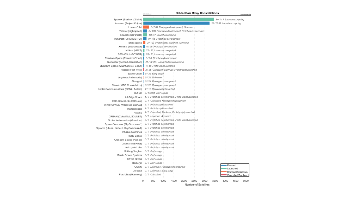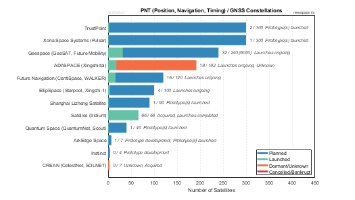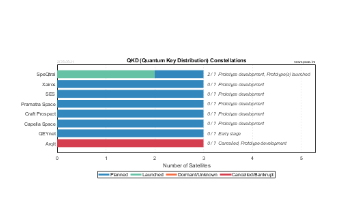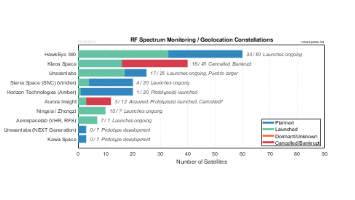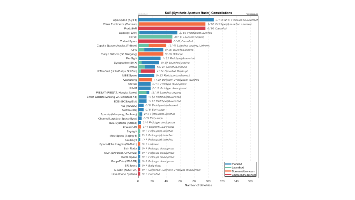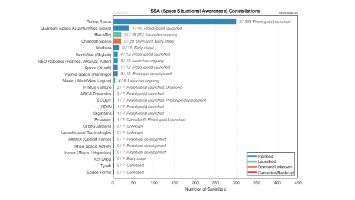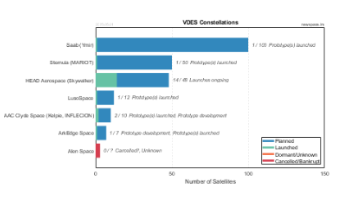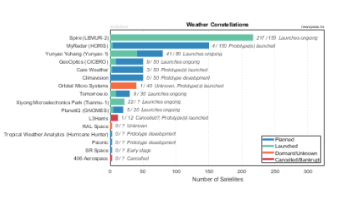NewSpace Index
Concise original overview of commercial satellite constellations,
small satellite rocket launchers and NewSpace funding options.
Sister websites www.nanosats.eu and www.factoriesinspace.com
NewSpace Constellations
Aiming to gather all commercial satellite constellations (megaconstellations) to this database. Active, planned and cancelled initiatives included.
Likely the first of its kind in public. First created in 2016 and constellations added one-by-one as discovered.
- Erik Kulu. "Satellite Constellations - 2024 Survey, Trends and Economic Sustainability." IAC 2024. Oct 17, 2024.
- Erik Kulu. "Small Launchers - 2023 Industry Survey and Market Analysis." 74th International Astronautical Congress (IAC 2023). Oct 4, 2023.
- Erik Kulu. "Small Launchers - 2021 Industry Survey and Market Analysis." 72nd International Astronautical Congress (IAC 2021). Oct 29, 2021.
- Erik Kulu. "Satellite Constellations - 2021 Industry Survey and Trends." 35th Annual Small Satellite Conference. Aug 10, 2021.
Graphs last update: 2025-05-31
432 constellations in the table below.
| Organization | Launched / Planned | First launch | Form factor | Field | Funding | Image |
|---|---|---|---|---|---|---|
| AprizeSat (SpaceQuest, AAC Clyde Space) | 12 / 12 | 2002 | Microsat | IoT / M2M, AIS | Yes, ? | |
| SaudiComsat | 7 / 24 | 2004 | Microsat | IoT / M2M | Yes, ? | |
| Spire (ExactEarth) | 68 / 67 | 2008 | Hosted, Microsat | AIS | Yes, ? | |
| Planet Labs (RapidEye) | 5 / 5 | 2008 | Smallsat | Earth Observation, Optical | N/A | |
| Globalstar (Second-Generation) | 25 / 42 | 2010 | Satellite | Internet, IoT / M2M, Orbital Data Relay, Direct-to-Cell, Satellite-to-Cellphone, Direct-to-Device | $1B+ | |
| Orbcomm (OG2) | 51 / 52 | 2012 | Microsat, Smallsat, 3U | IoT / M2M, AIS | Yes, ? | |
| SES (O3b/mPOWER) | 28 / 70 | 2013 | Satellite | Internet, Orbital Data Relay | Yes, ? | |
| Planet Labs (Flock, Dove, SuperDove) | 663 / 150 | 2013 | 3U | Earth Observation, Optical | $593.9M+ | |
| Planet Labs (Terra Bella, Skybox) | 15 / 24 | 2013 | Smallsat | Earth Observation, Optical | N/A | |
| Spire (LEMUR-2) | 217 / 150 | 2013 | 16U, 6U, 3U | Weather, AIS, ADS-B, Constellation-As-A-Service, GNSS Reflectometry, GNSS Radio Occultation, GNSS-RO, GNSS-R, Hosted Payloads, Microwave Sounder, Earthquake Monitoring | $220M+ | |
| SSTL (DMC-3/TripleSat) | 3 / 3 | 2015 | Satellite | Earth Observation, Optical | Yes, ? | |
| Chang Guang (CGSTL) (Jilin-1) | 134 / 300 | 2015 | Satellite | Earth Observation, Optical, Video, Night Lights | $375M+ | |
| BlackSky | 21 / 16 | 2016 | Microsat | Earth Observation, Optical, Non-Earth Imaging, SSA (Space Situational Awareness) | $253.5M | |
| GHGSat | 12 / 10 | 2016 | 16U, Microsat | Emissions Monitoring | $70M | |
| Satellogic (NuSat) | 48 / 90 | 2016 | Microsat | Earth Observation, Optical, Video, Constellation-As-A-Service | $119M+ | |
| SpaceWill | 5 / 16 | 2016 | Satellite | Earth Observation, Optical | Yes, ? | |
| Aireon | 75 / 75 | 2017 | Hosted | ADS-B | $50M | |
| DDK Positioning | 75 / 75 | 2017 | Hosted | GNSS | Yes | |
| Iridium (NEXT) | 75 / 75 | 2017 | Satellite | Internet, IoT / M2M, Orbital Data Relay, Constellation-As-A-Service, Direct-to-Cell, Satellite-to-Cellphone, Direct-to-Device | $3B+ | |
| Satelles (Iridium) | 66 / 66 | 2017 | Satellite | GNSS, PNT (Positioning; Navigation; Timing) | $29.3M | |
| GeoOptics (CICERO) | 9 / 50 | 2017 | 6U, 12U | Weather, GNSS-RO, GNSS Radio Occultation | $20.8M | |
| Hongyun / Xingyun (Xingyun-2) | 4 / 80 | 2017 | Smallsat | Internet, IoT / M2M | $404M+ | |
| Zhuhai Orbita (Zhuhai-1) | 12 / 10 | 2017 | Smallsat | Earth Observation, Hyperspectral | Yes | |
| Canon | 3 / 100 | 2017 | Microsat | Earth Observation, Optical | Yes | |
| HEAD Aerospace (Skywalker) | 14 / 48 | 2017 | Microsat | IoT / M2M, AIS, ADS-B, VDES (AIS 2.0) | Yes | |
| SpacePharma | 2 / ? | 2017 | 3U | Hosted Payloads, Microgravity Experiments | $5M+ | |
| ADASPACE (Xingshidai) | 18 / 192 | 2018 | Microsat, CubeSat | Earth Observation, Optical, PNT (Positioning; Navigation; Timing) | $125M+ | |
| Astranis (MicroGEO, Omega) | 6 / 100 | 2018 | Smallsat, Satellite | Internet | $750M+ | |
| Astrocast | 20 / 80 | 2018 | 3U | IoT / M2M | $67M+ | |
| Capella Space (Acadia, Whitney) | 15 / 40 | 2018 | Smallsat, Microsat | SAR, Earth Observation | $320M+ | |
| Earth-i (Vivid-i) | 1 / 15 | 2018 | Microsat | Earth Observation, Optical, Video | $3.5M | |
| Fleet Space (Alpha) | 10 / 140 | 2018 | 12U, Microsat, 6U, 3U, 1.5U | IoT / M2M, Minerals Prospecting | $170M+ | |
| Future Navigation (CentiSpace, WALKER) | 16 / 120 | 2018 | Microsat | GNSS, PNT (Positioning; Navigation; Timing) | Yes | |
| Guodian Gaoke (Apocalypse, Tianqi) | 36 / 38 | 2018 | Microsat, 6U, ? | IoT / M2M | Yes | |
| HawkEye 360 | 33 / 60 | 2018 | Microsat | RF Spectrum Monitoring, RF Geolocation | $400M+ | |
| Hongyan (CASC) | 1 / 320 | 2018 | Satellite | Internet | Yes | |
| ICEYE | 49 / 18 | 2018 | Microsat | SAR, Earth Observation | $500M+ | |
| Kepler Communications (GEN1) | 19 / 140 | 2018 | 6U, 3U | Store-and-Forward, IoT / M2M | $200M+ | |
| Kuva Space | 3 / 100 | 2018 | 16U, 6U, 2U | Earth Observation, Hyperspectral | $32M+ | |
| Myriota | 14 / 50 | 2018 | 6U, 3U | IoT / M2M | $68M+ | |
| OHB Italia (EAGLET) | 1 / 20 | 2018 | Microsat, 3U | Earth Observation, AIS, Optical | Yes | |
| SpaceChain | 6 / ? | 2018 | Hosted | Blockchain, Internet | $0.65M+ | |
| Spacety | 22 / 480 | 2018 | CubeSat? | Earth Observation, Optical | N/A | |
| SpaceX (Starlink Gen1) | 4714 / 4408 | 2018 | Smallsat | Internet | $1B+ | |
| Sputnix (Zorkiy-2M) | 5 / ? | 2018 | 12U, 6U, 3U | Earth Observation, Optical, AIS | N/A | |
| Swarm Technologies | 189 / 150 | 2018 | 0.25U, 1U | IoT / M2M | $27.7M | |
| MyRadar (HORIS) | 4 / 150 | 2019 | PocketQube | Earth Observation, Weather, Hyperspectral | Yes | |
| Alba Orbital | 18 / ? | 2019 | PocketQube | Earth Observation, Optical, Night Lights | $3.4M+ | |
| AST (SpaceMobile, BlueBird) | 5 / 243 | 2019 | Microsat, ? | Internet, Direct-to-Cell, Space-Based Cellular Broadband, Satellite-to-Cellphone, Direct-to-Device | $675M+ | |
| Axelspace (GRUS, Pyxis) | 11 / 50 | 2019 | Microsat | Earth Observation, Optical, Constellation-As-A-Service | $100.8M+ | |
| BeetleSat (NSLComm) | 2 / 264 | 2019 | Smallsat, 6U | Internet, IoT / M2M | $9.25M+ | |
| Elbit Systems (NANOVA) | 1 / ? | 2019 | 3U | IoT / M2M | Yes | |
| OneWeb (Gen 1) | 660 / 648 | 2019 | Smallsat | Internet | $4.6B ($2.7B) | |
| Fossa Systems | 24 / 80 | 2019 | 3U, PocketQube | IoT / M2M | $8M+ | |
| Hera Systems | 1 / 50 | 2019 | 12U | Earth Observation, Optical | $5.2M+ | |
| iQPS | 9 / 36 | 2019 | Microsat | SAR, Earth Observation | $90M+ | |
| Lacuna Space | 6 / 240 | 2019 | 3U, 6U | IoT / M2M | $5.9M | |
| Lynk (Tower) | 10 / 10 | 2019 | Microsat, Hosted, CubeSat | IoT / M2M, Satellite-to-Cellphone, Direct-to-Cell, Direct-to-Device | $30M | |
| Ningxia / Zhongzi | 10 / ? | 2019 | Smallsat | SIGINT, RF Spectrum Monitoring | Yes | |
| Orbital Micro Systems | 1 / 40 | 2019 | 3U? | Weather | $4.2M | |
| SatRev (STORK, REC) | 9 / 1024 | 2019 | 6U, 2U | Earth Observation, Optical, Moon | $43M+ | |
| Sen (EarthTV) | 2 / ? | 2019 | 16U | Earth Observation, Optical, Video | $6.0M+ | |
| Shanghai Lizheng Satellite | 1 / 90 | 2019 | Microsat | GNSS, IoT / M2M, PNT (Positioning; Navigation; Timing) | Yes | |
| Stara Space | 2 / 120 | 2019 | PocketQube | Orbital Data Relay, Data Storage | $1M+ | |
| SpeQtral | 2 / ? | 2019 | CubeSat? | QKD (Quantum Key Distribution), Laser Communications | $10.2M | |
| Unseenlabs | 17 / 25 | 2019 | 8U, 6U | RF Spectrum Monitoring, RF Geolocation | $128M+ | |
| ZeroG Lab (Lingque, Magpie, Golden Bauhinia) | 7 / 132 | 2019 | 6U, Microsat, ? | Earth Observation, Optical | $3.2M | |
| China Electronics (Tianxian) | 1 / 96 | 2020 | Smallsat | SAR, Earth Observation | Yes | |
| Galaxy Space (Yinhe) | 8 / 1000 | 2020 | Smallsat | Internet, 5G | Yes | |
| Golbriak Space | 2 / ? | 2020 | 6U, ? | Laser Communications | $0.2M+ | |
| PlanetiQ (GNOMES) | 5 / 20 | 2020 | Microsat | Weather, GNSS-RO, GNSS Radio Occultation | $23.9M | |
| SATLANTIS (GARAI, GEI-SAT, GEISAT) | 3 / 3 | 2020 | Smallsat, 16U | Earth Observation, Optical, Emissions Monitoring | $40.2M | |
| SpaceX (Starshield) | 195 / ? | 2020 | Satellite, Smallsat | Earth Observation, Hosted Payloads, Orbital Data Relay, Optical | $1B+ | |
| Spacety (SAR) | 2 / 56 | 2020 | Smallsat | SAR, Earth Observation | $22M+ | |
| Synspective (StriX) | 5 / 30 | 2020 | Smallsat | SAR, Earth Observation | $230M | |
| Aerospacelab (VHR, RFS) | 7 / ? | 2021 | Smallsat, Microsat, 12U | Earth Observation, Optical, RF Geolocation, SIGINT, RF Spectrum Monitoring | $71M+ | |
| Airbus (Pleiades Neo) | 4 / 4 | 2021 | Satellite | Earth Observation, Optical | Yes | |
| Apogeo Space (PiCo, FEES Cluster) | 18 / ? | 2021 | 0.33U | IoT / M2M | $5M+ | |
| Care Weather | 3 / 50 | 2021 | Nanosat, PocketQube, 1U | Weather | $0.5M+ | |
| Cshark | 1 / ? | 2021 | PocketQube | IoT / M2M | Yes | |
| Elecnor Deimos (NEPTUNO) | 1 / ? | 2021 | 3U | AIS, Maritime | Yes | |
| Geespace (GeeSAT, Future Mobility) | 32 / 240 | 2021 | Smallsat | Internet, PNT (Positioning; Navigation; Timing), Earth Observation, Optical, Direct-to-Cell | $326M+ | |
| Hangsheng Satellite (Zhongan Guotong 1) | 1 / ? | 2021 | ? | Earth Observation, Optical | Yes | |
| Hydra Space | 5 / ? | 2021 | PocketQube | IoT / M2M | Seed | |
| Loft Orbital (YAM) | 6 / 10 | 2021 | Microsat | Constellation-As-A-Service, Hosted Payloads, Earth Observation, Hyperspectral, In-Orbit Computing | $326M+ | |
| Mino Space (Taijing-1, Taijing-2, Taijing-3) | 8 / ? | 2021 | Smallsat | Earth Observation, Optical | N/A | |
| OQ Technology | 10 / 60 | 2021 | CubeSat, 1U? | IoT / M2M, Direct-to-Cell, Direct-to-Device, Satellite-to-Cellphone | $15M+ | |
| Orbital Sidekick (GHOSt) | 7 / 14 | 2021 | Microsat | Earth Observation, Hyperspectral | $46.7M+ | |
| Orbitare (Spaceloop) | 2 / 126 | 2021 | CubeSat | IoT / M2M | $0.05M+ | |
| Quub | 3 / 240 | 2021 | PocketQube, 3U | Earth Observation | Yes, ? | |
| Sateliot (GroundBreaker) | 6 / 68 | 2021 | 6U, 3U | IoT / M2M, Satellite-to-Cellphone, Direct-to-Cell, Direct-to-Device | $140M+ | |
| Spacety (Tiansuan, Celestial Calculations) | 1 / 8 | 2021 | CubeSat? | Internet | N/A | |
| Telnet | 1 / ? | 2021 | 3U | IoT / M2M | Yes | |
| Umbra | 10 / 24 | 2021 | Microsat | SAR, Earth Observation | $32M+ | |
| WARPSPACE (WarpHub InterSat) | 2 / ? | 2021 | Smallsat | Orbital Data Relay, Laser Communications | $9M | |
| Yunyao Yuhang (Yunyao-1) | 41 / 80 | 2021 | ? | Weather, GNSS-RO, Infrared, Earth Observation | $14.8M+ | |
| ARCA Dynamics | 2 / ? | 2022 | CubeSat | SSA (Space Situational Awareness), Earth Observation | $1.4M+ | |
| Aistech (Guardian) | 1 / 20 | 2022 | 6U, 2U | Infrared, Earth Observation | $5.7M+ | |
| ConstelIR (HIVE) | 2 / 30 | 2022 | Microsat, CubeSat? | Infrared, Earth Observation | $47M+ | |
| Cryptosat | 2 / ? | 2022 | CubeSat | In-Orbit Computing | $3M | |
| E-Space | 4 / 1000 | 2022 | Microsat, ? | Internet, Space Debris Removal, IoT / M2M | $56M | |
| Findus Venture | 2 / ? | 2022 | 6U | SSA (Space Situational Awareness) | Yes | |
| Hancom | 1 / 50 | 2022 | CubeSat | Earth Observation, Optical | Yes | |
| Innova Space (Libertadores de América) | 6 / 100 | 2022 | PocketQube | IoT / M2M | Yes | |
| Lunasonde (Gossamer) | 2 / ? | 2022 | 1U, ? | Minerals Prospecting, Subsurface Imaging | Yes | |
| Mino Space (Taijing-4) | 2 / ? | 2022 | Smallsat | SAR, Earth Observation | $260M+ | |
| Omnispace | 2 / 200 | 2022 | 12U | IoT / M2M, 5G | $60M+ | |
| ArkEdge Space | 1 / 7 | 2022 | 6U | VDES (AIS 2.0), IoT / M2M, Constellation-As-A-Service, Hosted Payloads, Orbital Data Relay, Moon, PNT (Positioning; Navigation; Timing) | $73M+ | |
| VariSat (Omniteq) (VariSat) | 3 / ? | 2022 | 6U | VHF Radio Communications | Yes | |
| OroraTech (FOREST, Walker-Star) | 11 / 100 | 2022 | 8U, 6U, 3U | Earth Observation, Infrared | $65M+ | |
| PION Labs | 1 / ? | 2022 | PocketQube | IoT / M2M | ? | |
| Pixxel (Firefly, FFLY) | 5 / 18 | 2022 | Microsat, 6U | Earth Observation, Hyperspectral | $95M+ | |
| Plan-S (Connecta IoT Network) | 8 / 75 | 2022 | 6U, 3U | IoT / M2M | Yes | |
| WISeSat Space | 2 / ? | 2022 | 3U, PocketQube | IoT / M2M | Yes | |
| Xona Space Systems (Pulsar) | 1 / 300 | 2022 | Microsat | GNSS, PNT (Positioning; Navigation; Timing) | $44M+ | |
| AAC Clyde Space (Kelpie, INFLECION) | 2 / 10 | 2023 | 6U | Constellation-As-A-Service, AIS, Optical, VDES (AIS 2.0) | $22.5M+ | |
| Amazon (Project Kuiper) | 29 / 3236 | 2023 | Satellite | Internet, Orbital Data Relay | Yes | |
| CONTEC | 2 / ? | 2023 | 16U, 2U | Earth Observation, Optical | Yes, ? | |
| Digantara | 1 / ? | 2023 | CubeSat, 6U, 12U | SSA (Space Situational Awareness) | $12.6M | |
| EllipSpace (Starpool, Xingchi-1) | 4 / 100 | 2023 | Smallsat, Microsat | Internet, PNT (Positioning; Navigation; Timing), IoT / M2M, Earth Observation | $40M+ | |
| EOS (EOSAgriSat) | 1 / 12 | 2023 | Microsat | Earth Observation, SAR | Yes | |
| EOS Orbit | 2 / ? | 2023 | 3U | IoT / M2M | Yes | |
| OneWeb (Gen 2) | 1 / ? | 2023 | Smallsat | Internet | N/A | |
| Grasp (GAPMAP, Climate-n) | 1 / 10 | 2023 | CubeSat | Emissions Monitoring | $2M | |
| HEO Robotics (Holmes, ARGUS, Adler) | 3 / 12 | 2023 | Hosted | SSA (Space Situational Awareness), In-Orbit Inspection | $7.8M+ | |
| Hello Space | 3 / 80 | 2023 | PocketQube | IoT / M2M | Yes | |
| Horizon Technologies (Amber) | 1 / 20 | 2023 | 6U, 12U | RF Spectrum Monitoring, SIGINT | Yes | |
| Huawei (Hua Chain) | 4 / ? | 2023 | ? | Internet | Yes, ? | |
| ISI (ImageSat International) (Global Eye) | 1 / ? | 2023 | Smallsat | Earth Observation, Optical | Yes | |
| Kepler Communications (GEN2, Aether) | 2 / 18 | 2023 | Smallsat | Orbital Data Relay, Laser Communications, In-Orbit Computing | $200M+ | |
| Muon Space (Climate Constellation) | 2 / ? | 2023 | Microsat | Constellation-As-A-Service, Earth Observation, Optical, Hyperspectral, Hosted Payloads | $91.7M | |
| Nara Space (NarSha) | 1 / 12 | 2023 | CubeSat | Earth Observation, Emissions Monitoring, Hyperspectral | $24.3M+ | |
| NuSpace | 1 / ? | 2023 | CubeSat | IoT / M2M | Seed | |
| ODIN | 1 / ? | 2023 | Hosted, CubeSat | SSA (Space Situational Awareness), Space Debris Monitoring | ? | |
| Open Cosmos (OpenConstellation) | 4 / 25 | 2023 | CubeSat | Earth Observation, Constellation-As-A-Service, Optical | $62.6M+ | |
| Planet Labs (Pelican) | 2 / 32 | 2023 | Smallsat | Earth Observation, Optical | N/A | |
| Promethee (JAPETUS) | 1 / 20 | 2023 | Microsat, CubeSat? | Earth Observation, Optical, Hyperspectral | $8M | |
| Quantum Generative Materials (GenMat) | 1 / 600 | 2023 | CubeSat, 6U | Earth Observation, Hyperspectral | $25M+ | |
| Rogue Space Systems (Orbot) | 1 / 40 | 2023 | 12U, 16U | On-Orbit Servicing, In-Orbit Inspection, Hosted Payloads | $1.6M+ | |
| Saab (Ymir) | 1 / 100 | 2023 | 3U | VDES (AIS 2.0) | Yes | |
| SatVu | 1 / 8 | 2023 | Smallsat | Earth Observation, Infrared | $51.9M+ | |
| Sierra Space (SNC) (Vindler) | 4 / 20 | 2023 | Microsat, 6U | RF Spectrum Monitoring | Yes | |
| Sitronics (SITRO-AIS) | 52 / 70 | 2023 | 3U | AIS | Yes, ? | |
| Skysight | 3 / ? | 2023 | Smallsat, ? | SAR, Earth Observation, Infrared | Yes, ? | |
| Skykraft (Foundation) | 10 / 210 | 2023 | Microsat, ? | ADS-B, VHF Radio Communications | $86M+ | |
| Spacety (Mianyang, Fucheng) | 2 / 6 | 2023 | Satellite | SAR, Earth Observation, InSAR | N/A | |
| SpaceX (Starlink V2 Mini) | 3441 / ? | 2023 | Satellite | Internet, Orbital Data Relay | $1B+ | |
| Sternula (MARIOT) | 1 / 50 | 2023 | CubeSat? | VDES (AIS 2.0), IoT / M2M | $1.4M+ | |
| Tomorrow.io | 9 / 30 | 2023 | 6U, Microsat, ? | Weather, Microwave Sounder | $270M+ | |
| Transcelestial | 1 / ? | 2023 | CubeSat? | Orbital Data Relay, Laser Communications | $24M | |
| TrustPoint | 2 / 300 | 2023 | CubeSat? | GNSS, PNT (Positioning; Navigation; Timing) | $2M+ | |
| Turion Space | 2 / 300 | 2023 | Microsat | SSA (Space Situational Awareness), On-Orbit Servicing, Active Debris Removal, Non-Earth Imaging | $18M+ | |
| Wyvern | 3 / 36 | 2023 | Microsat, CubeSat | Earth Observation, Hyperspectral | $15M+ | |
| Xiyong Microelectronics Park (Tianmu-1) | 22 / ? | 2023 | Smallsat | Weather, GNSS Radio Occultation | Yes, ? | |
| PIESAT (PIESAT, Hongtu, Nuwa) | 12 / 16 | 2023 | Satellite | Earth Observation, SAR, Multistatic SAR | Yes, ? | |
| Anuvu (Constellation) | 2 / 8 | 2024 | Satellite | Internet | $50M+ | |
| Avant Space (Constellation) | 1 / 20 | 2024 | 16U | Orbital Display (Advertising) | ? | |
| Carbon Mapper | 1 / ? | 2024 | Smallsat | Hyperspectral, Earth Observation | Yes | |
| Guo Wang, Xingwang (Chuangxin-20, CX-20, WHWD) | 29 / 12992 | 2024 | Satellite, ? | Internet | Yes, ? | |
| Esper | 3 / 18 | 2024 | CubeSat? | Earth Observation, Hyperspectral, Emissions Monitoring, Minerals Prospecting | $4.6M+ | |
| GalaxEye | 1 / ? | 2024 | ? | Earth Observation, Optical, SAR | $10M+ | |
| Hubble Network | 3 / 68 | 2024 | 16U | IoT / M2M | $20M+ | |
| Hydrosat | 1 / 16 | 2024 | Microsat, ? | Earth Observation, Infrared | $35.6M | |
| Kineis | 25 / 15 | 2024 | Microsat | IoT / M2M, AIS | $112M | |
| Maxar (WorldView Legion) | 4 / 6 | 2024 | Satellite | Earth Observation, Optical, SSA (Space Situational Awareness) | Yes | |
| Micro Orbiter (MOSAIC) | 1 / ? | 2024 | 3U, 1U | IoT / M2M | $0.65M+ | |
| NorthStar (Skylark) | 4 / 12 | 2024 | 16U, Satellite | SSA (Space Situational Awareness) | $120M+ | |
| ONDO Space | 12 / 100 | 2024 | 0.5U | IoT / M2M | ? | |
| PierSight | 1 / 32 | 2024 | Microsat | SAR, AIS | $8M+ | |
| Planet Labs (Tanager) | 1 / ? | 2024 | Smallsat | Earth Observation, Hyperspectral | N/A | |
| PT Scientists | 1 / 3 | 2024 | CubeSat? | In-Orbit Computing | Yes, ? | |
| Quantum Space (QuantumNet, Scout) | 1 / 40 | 2024 | Smallsat | Hosted Payloads, PNT (Positioning; Navigation; Timing), SSA (Space Situational Awareness), Orbital Data Relay | $15M+ | |
| SCOUT | 1 / ? | 2024 | Smallsat, ? | In-Orbit Inspection, SSA (Space Situational Awareness) | $5.5M | |
| Sidus Space (LizzieSat) | 3 / 100 | 2024 | Microsat | Constellation-As-A-Service, In-Orbit Computing | $24M | |
| Smart Satellite (Zhixing 2A, SmartSat X1) | 1 / 12 | 2024 | Smallsat, Satellite | SAR, Earth Observation | $1.4M | |
| Spacecoin | 1 / 250 | 2024 | 8U, CubeSat? | Internet, Direct-to-Cell | Yes, ? | |
| Genesat (Qianfan, G60, Thousand Sails) | 72 / 1296 | 2024 | Smallsat, ? | Internet | $1B+ | |
| SpaceX (Starlink V2 Mini DTC) | 635 / 840 | 2024 | Satellite | Direct-to-Cell, Direct-to-Device, Satellite-to-Cellphone | $1B+ | |
| Xplore (Xcraft) | 1 / 12 | 2024 | CubeSat?, Smallsat | Hyperspectral, Earth Observation, SSA (Space Situational Awareness) | $25M+ | |
| Absolut Sensing (GESat) | 1 / 24 | 2025 | 16U | Emissions Monitoring, Hyperspectral | $13M | |
| Albedo Space (Clarity) | 1 / 6 | 2025 | Smallsat, ? | Earth Observation, Optical, Infrared, VLEO | $93M+ | |
| Argotec (HEO (Hawk for Earth Observation)) | 1 / 40 | 2025 | Microsat | Earth Observation | Yes | |
| EchoStar (Lyra) | 1 / 28 | 2025 | Microsat | IoT / M2M, Direct-to-Device | Yes, ? | |
| EnduroSat (Balkan) | 1 / 120 | 2025 | CubeSat? | Earth Observation, Optical | $28.6M+ | |
| Kongsberg (N3X, ARVAKER) | 1 / 3 | 2025 | Microsat | AIS | Yes | |
| LusoSpace | 1 / 12 | 2025 | 8U, 3U | VDES (AIS 2.0), AIS | Yes, ? | |
| Mission Space | 1 / 24 | 2025 | Hosted, 3U, 6U | Space Weather | $0.7M+ | |
| Muon Space (FireSat Constellation) | 1 / 50 | 2025 | Microsat | Earth Observation, Infrared | N/A | |
| Startical | 1 / 288 | 2025 | Smallsat, CubeSat | ADS-B, VHF Radio Communications | $17.6M+ | |
| AAC Clyde Space (Cyclops, xSPANCION) | 0 / 10 | 2025 | 16U | Earth Observation, Optical, Constellation-As-A-Service | N/A | |
| Aetherflux | 0 / ? | 2025 | Smallsat | Wireless Energy Supply | $60M+ | |
| AIRMO | 0 / 12 | 2025 | CubeSat? | Emissions Monitoring, LIDAR, Infrared | $5.8M+ | |
| Akula Tech | 0 / ? | 2025 | ? | Infrared, Earth Observation | Yes, ? | |
| Almagest | 0 / 24 | 2025 | ? | Orbital Data Relay, Internet | ? | |
| Alya Space (Alya 1) | 0 / 108 | 2025 | 8U, Microsat | Earth Observation, Hyperspectral, SAR | ? | |
| Amini | 0 / 6 | 2025 | ? | Earth Observation, Optical | $6M | |
| Anduril | 0 / ? | 2025 | ? | Earth Observation, Infrared, In-Orbit Computing, ? | $3.7B+ | |
| Astrogate Labs | 0 / ? | 2025 | 3U, 6U | Orbital Data Relay, Laser Communications | Yes | |
| BAE Systems (Azalea) | 0 / 4 | 2025 | Smallsat | Earth Observation, SAR, Optical, RF Geolocation | Yes, ? | |
| Bluelink Satcom | 0 / 72 | 2025 | Microsat, ? | IoT / M2M, Bluetooth | $3M+ | |
| Climavision | 0 / 50 | 2025 | ? | Weather | $100M | |
| Crescent Space (Parsec) | 0 / ? | 2025 | Smallsat | Orbital Data Relay, Moon | Yes, ? | |
| EarthDaily Analytics (EarthDaily, YAC-1) | 0 / 10 | 2025 | Microsat | Earth Observation, Optical | Yes | |
| EOI Space (Stingray) | 0 / 30 | 2025 | Smallsat | Earth Observation, Optical, VLEO | $2M+ | |
| GALAXIA Mission Systems (MÖBIUS) | 0 / 24 | 2025 | CubeSat | Earth Observation, In-Orbit Computing | $1.5M+ | |
| Globalstar (Second-Gen Refresh) | 0 / 17 | 2025 | Smallsat, ? | Internet, IoT / M2M | N/A | |
| Hongqing Technology (Honghu-3) | 0 / 10000 | 2025 | ? | Internet | Yes, ? | |
| HyperSat | 0 / 6 | 2025 | Smallsat | Earth Observation, Hyperspectral | $85M | |
| HySpecIQ (HySpec) | 0 / 12 | 2025 | Satellite | Earth Observation, Hyperspectral | $20M+ | |
| Inmarsat (ORCHESTRA) | 0 / 175 | 2025 | Satellite | Internet, Direct-to-Cell, Direct-to-Device, IoT / M2M, Orbital Data Relay | Yes | |
| Inovor (Skyris / Hyperion) | 0 / ? | 2025 | 12U | SSA (Space Situational Awareness), Earth Observation | Yes | |
| Instinct | 0 / 4 | 2025 | CubeSat? | PNT (Positioning; Navigation; Timing), Moon | $0.4M+ | |
| Intuitive Machines | 0 / ? | 2025 | Microsat | Orbital Data Relay | $100M+ | |
| Iota Technology | 0 / 3 | 2025 | 4U | Geomagnetic | $1M+ | |
| Kawa Space | 0 / ? | 2025 | CubeSat | AIS, RF Spectrum Monitoring, RF Geolocation | $1.2M | |
| MDA (SARnext, CHORUS) | 0 / ? | 2025 | Satellite | SAR, Earth Observation | Yes, ? | |
| NIBE Space | 0 / 23 | 2025 | Smallsat | Earth Observation, SAR, Infrared | Yes, ? | |
| NUVIEW | 0 / 20 | 2025 | ? | Earth Observation, LIDAR, 3D Imaging | $15M+ | |
| Plan-S (Observa) | 0 / ? | 2025 | 6U, 3U | Earth Observation | Yes, ? | |
| Reflect Orbital | 0 / 57 | 2025 | ? | Wireless Energy Supply | $26.5M+ | |
| Rhea Space Activity | 0 / ? | 2025 | CubeSat? | SSA (Space Situational Awareness) | $0.7M | |
| SatSure (KaleidEO) | 0 / 4 | 2025 | Microsat | Earth Observation, Optical | $15M+ | |
| SES | 0 / ? | 2025 | Smallsat | QKD (Quantum Key Distribution) | N/A | |
| Skyloom (Uhura, Node-1, SkyCompass-1) | 0 / ? | 2025 | Microsat | Orbital Data Relay, Laser Communications | $30M+ | |
| Space Compass (SkyCompass-1) | 0 / ? | 2025 | Satellite | Orbital Data Relay, Laser Communications | $130M+ | |
| SpaceX (Starlink V3) | 0 / 7500 | 2025 | Satellite | Internet, Direct-to-Cell, Satellite-to-Cellphone, Direct-to-Device | $1B+ | |
| Star Catcher | 0 / ? | 2025 | ? | Wireless Energy Supply | $12M | |
| TALOS (ICARUS) | 0 / 5 | 2025 | CubeSat | IoT / M2M | ? | |
| TelePIX | 0 / ? | 2025 | CubeSat | Earth Observation, Emissions Monitoring | Yes, ? | |
| Vyoma Space (Flamingo) | 0 / 12 | 2025 | Microsat, ? | SSA (Space Situational Awareness) | $9.5M+ | |
| Xairos | 0 / ? | 2025 | 6U, ? | QKD (Quantum Key Distribution), Laser Communications | Yes, ? | |
| GUMUSH (Taurus) | 0 / ? | 2025 | 0.25U, 3U | IoT / M2M | Yes, ? | |
| Orbital Astronautics (Guardian) | 0 / ? | 2025 | 6U | Orbital Data Relay, 3D Imaging | Yes | |
| Rapid Cubes | 0 / 4 | 2025 | 16U | IoT / M2M, Hosted Payloads | Yes, ? | |
| SpaceAble | 0 / ? | 2025 | CubeSat | SSA (Space Situational Awareness), Space Weather | Yes | |
| Lumen Orbit | 0 / 300 | 2025 | Microsat | Space Data Center, Orbital Data Relay, Data Storage, In-Orbit Computing | $2.4M+ | |
| 4pi Lab (EPiC) | 0 / 16 | 2025 | ? | Earth Observation, Infrared | Yes | |
| Berkelyn | 0 / ? | 2025 | 16U | Asteroid Prospecting, Orbital Data Relay | ? | |
| Concert Technologies | 0 / ? | 2025 | CubeSat? | Earth Observation, IoT / M2M | ? | |
| Laser Light (HALO) | 0 / 12 | 2025 | Smallsat | Laser Communications | $100M+ | |
| Methera | 0 / 16 | 2025 | Smallsat | Internet, SSA (Space Situational Awareness) | Seed | |
| Metrea (XR) | 0 / 8 | 2025 | Microsat, ? | SAR, Earth Observation | Yes | |
| Astrome (Gigamesh / SpaceNet) | 0 / 198 | 2025 | Microsat | Internet | $13.4M+ | |
| Cloud Constellation (SpaceBelt) | 0 / 12 | 2025 | Smallsat | Data Storage | $100M | |
| Hanwha Systems | 0 / 2000 | 2025 | ? | Internet, 6G | Yes | |
| Ingenu (AFNIO) | 0 / 72 | 2025 | Microsat, ? | IoT / M2M | Yes | |
| Launchspace Technologies | 0 / ? | 2025 | ? | SSA (Space Situational Awareness), Active Debris Removal | ? | |
| Scepter | 0 / 24 | 2025 | Microsat | Emissions Monitoring | ? | |
| Tianjin Satcom (36 Tiangang) | 0 / 36 | 2025 | ? | SAR, Earth Observation, Hyperspectral, Optical | Yes | |
| UNIO | 0 / 1000 | 2025 | Smallsat | Internet, Laser Communications | $2.7M+ | |
| Mangata Networks | 0 / 791 | 2025 | Satellite | Internet, 5G | $33M+ | |
| Constellation Technologies | 0 / 1500 | 2026 | Satellite | Internet | $10.1M+ | |
| Craft Prospect | 0 / ? | 2026 | ? | QKD (Quantum Key Distribution) | $2.5M+ | |
| LatConnect 60 (SWIRSAT) | 0 / 3 | 2026 | Microsat | Earth Observation, Optical | ? | |
| LUMIR | 0 / 18 | 2026 | Microsat, ? | SAR | Yes, ? | |
| Marble Imaging | 0 / 200 | 2026 | Microsat | Earth Observation, Optical | $0.7M+ | |
| Orbitworks (Altair) | 0 / 10 | 2026 | Smallsat | Earth Observation | $100M+ | |
| Rivada (OuterNET) | 0 / 300 | 2026 | Smallsat, ? | Internet | $80M | |
| SatLeo | 0 / ? | 2026 | Microsat, ? | Earth Observation, Infrared | $3.3M+ | |
| Sisir Radar | 0 / ? | 2026 | ? | SAR | $1.5M | |
| SpinLaunch (Meridian Space) | 0 / 280 | 2026 | Microsat | Internet | $150M+ | |
| Telesat (Lightspeed) | 0 / 198 | 2026 | Smallsat | Internet, Orbital Data Relay | $2B+ | |
| Unseenlabs (NEXT Generation) | 0 / ? | 2026 | Smallsat | RF Spectrum Monitoring, RF Geolocation | N/A | |
| Volta (LightGrid) | 0 / 30 | 2026 | ? | Wireless Energy Supply | $0.1M+ | |
| Xenesis (Intercessor) | 0 / 98 | 2026 | ? | Orbital Data Relay, Laser Communications | ? | |
| Globalstar (Third Generation) | 0 / 50 | 2027 | Smallsat, ? | Internet, IoT / M2M | N/A | |
| Logos Space | 0 / 1092 | 2027 | ? | Internet | Yes, ? | |
| Lonestar | 0 / 6 | 2027 | Hosted, ? | Data Storage | $5.8M | |
| Spiral Blue | 0 / 20 | 2027 | Microsat, ? | 3D Imaging, LIDAR | $0.12M+ | |
| 4iG (HULEO) | 0 / 8 | 2028 | ? | Earth Observation, Optical, SAR | Yes, ? | |
| KappaZeta (3D-SAR) | 0 / 3 | 2028 | Smallsat, ? | SAR, 3D Imaging, Earth Observation, Multistatic SAR | $0.5M+ | |
| SpaceRISE (IRIS2) | 0 / 290 | 2029 | ? | Internet, 5G | Yes, ? | |
| AS23.Space (Nebula Data) | 0 / 210 | ? | Hosted, CubeSat?, ? | Data Storage | ESA BIC UK | |
| Blue Skies Space | 0 / ? | ? | ? | Astrophotography | $2.5M+ | |
| Capella Space | 0 / ? | ? | Smallsat, Microsat | QKD (Quantum Key Distribution) | $320M+ | |
| Chascii (INSPIRE) | 0 / ? | ? | 6U | Orbital Data Relay, Laser Communications | ? | |
| Connected | 0 / ? | ? | ? | IoT / M2M | $2.2M | |
| Delta Space | 0 / ? | ? | CubeSat? | IoT / M2M | $0.13M+ | |
| Hualu Space | 0 / 3 | ? | ? | Orbital Data Relay | Yes, ? | |
| iMetalX (Optical Fence) | 0 / ? | ? | ? | SSA (Space Situational Awareness), Space Debris Monitoring, Active Debris Removal, Non-Earth Imaging | $0.1M+ | |
| Kapta Space | 0 / ? | ? | ? | SAR, Earth Observation | $1M+ | |
| LEOBLUE | 0 / ? | ? | ? | IoT / M2M, Direct-to-Device, Direct-to-Cell, Satellite-to-Cellphone | ? | |
| Matter (EARTH) | 0 / ? | ? | ? | Earth Observation, Hyperspectral, Infrared | $12M+ | |
| Phantom Space (Phantom Cloud) | 0 / 66 | ? | ? | Orbital Data Relay | $5.9M+ | |
| Pramatra Space | 0 / ? | ? | ? | QKD (Quantum Key Distribution) | $0.1M+ | |
| Psionic | 0 / ? | ? | ? | Weather | Yes, ? | |
| SaraniaSat | 0 / ? | ? | 6U | Earth Observation, Hyperspectral, Infrared | $5M+ | |
| SARsat | 0 / 18 | ? | ? | SAR, Optical | $4.4M | |
| StarVision (OSE) | 0 / 252 | ? | Smallsat, ? | Earth Observation, In-Orbit Computing, Space Data Center | Yes, ? | |
| ToSpace | 0 / ? | ? | PocketQube, ? | IoT / M2M | ? | |
| Tropical Weather Analytics (Hurricane Hunter) | 0 / ? | ? | 12U | Weather | $0.1M+ | |
| Viasat (MEO Constellation) | 0 / 20 | ? | Satellite | Internet, Orbital Data Relay | Yes, ? | |
| AcTLAbS | 0 / ? | ? | CubeSat | SSA (Space Situational Awareness), Space Debris Monitoring | ? | |
| Angkasa-X (A-SEANLINK) | 0 / 500 | ? | ? | Internet | ? | |
| Apogee Networks | 0 / ? | ? | ? | Internet | ? | |
| Bifrost Orbital | 0 / ? | ? | CubeSat? | Orbital Data Relay | $0.4M | |
| CAVU Aerospace | 0 / 24 | ? | ? | IoT / M2M, Wireless Energy Supply | ? | |
| Channel Logistics (Space Eyes) | 0 / 5 | ? | ? | SAR, AIS, Earth Observation | ? | |
| DeepSat | 0 / ? | ? | ? | Earth Observation, Optical | ||
| Grahaa Space | 0 / ? | ? | CubeSat? | Earth Observation, Video | ? | |
| Hughes | 0 / 1440 | ? | ? | Internet | Yes | |
| IMTsrl (BISS) | 0 / ? | ? | 6U | IoT / M2M | Yes | |
| Infinity Space | 0 / ? | ? | CubeSat? | Earth Observation, Hyperspectral, Minerals Prospecting | ? | |
| Interstellar Technologies | 0 / ? | ? | ? | Direct-to-Cell | $129M+ | |
| Meraki Space Systems | 0 / ? | ? | ? | Orbital Data Relay, Moon, Laser Communications | ? | |
| NordSpace | 0 / 8 | ? | ? | IoT / M2M, Earth Observation | ? | |
| ORiS | 0 / ? | ? | ? | Wireless Energy Supply, Space Debris Removal | Yes, ? | |
| Outlyer | 0 / 15 | ? | ? | Orbital Data Relay | ||
| Precursor | 0 / ? | ? | ? | Space Weather, Earthquake Monitoring | ? | |
| QEYnet | 0 / ? | ? | Microsat | QKD (Quantum Key Distribution), Laser Communications | Yes | |
| Shifang Xinglian | 0 / ? | ? | ? | Orbital Data Relay | Yes | |
| Southern Cross Space | 0 / ? | ? | Microsat | Earth Observation, Optical | ? | |
| Space Union | 0 / 32 | ? | CubeSat | Orbital Data Relay | ? | |
| SPACEVLEO | 0 / ? | ? | ? | Earth Observation, Optical, VLEO | ? | |
| SR Space | 0 / ? | ? | Satellite | SAR, Weather, Optical, Infrared, IoT / M2M | Yes | |
| Starmesh | 0 / ? | ? | ? | Internet | ? | |
| Terra Space | 0 / ? | ? | CubeSat? | Earth Observation, Infrared | ? | |
| Argotec (Andromeda) | 0 / 24 | ? | Microsat | Orbital Data Relay, Moon | Yes | |
| AT&T | 0 / ? | ? | CubeSat? | IoT / M2M | Yes | |
| ConnectX (FIRST) | 0 / ? | ? | ? | Data Storage | ? | |
| CREAN (CelestNet, SOLNET) | 0 / ? | ? | ? | Orbital Data Relay, Moon, PNT (Positioning; Navigation; Timing) | $0.7M | |
| Live Earth | 0 / 3 | ? | Satellite | Earth Observation, Optical, Infrared | ? | |
| Globalstar (Gen4) | 0 / 3080 | ? | Smallsat, ? | Internet, Direct-to-Cell, Direct-to-Device, Satellite-to-Cellphone | N/A | |
| Nebula Space | 0 / ? | ? | ? | In-Orbit Computing | $0.55M | |
| NorthStar | 0 / 12 | ? | 16U, Satellite | Earth Observation, Infrared, Hyperspectral | N/A | |
| NTT | 0 / ? | ? | ? | Internet, Data Storage, Space Data Center | Yes, ? | |
| OrbitGuardians | 0 / ? | ? | CubeSat? | Active Debris Removal, In-Orbit Inspection, SSA (Space Situational Awareness), Space Debris Monitoring | Yes, ? | |
| RAL Space | 0 / ? | ? | ? | Weather, Hyperspectral | ? | |
| Rocket Lab | 0 / ? | ? | Smallsat, ? | Internet, ? | $1.2B+ | |
| Skeyeon | 0 / ? | ? | Smallsat | Earth Observation, VLEO | $1.8M | |
| SpaceAlpha Insights (SAR-XL) | 0 / ? | ? | Satellite | SAR, Earth Observation | Yes | |
| Spin.Works | 0 / ? | ? | CubeSat? | Gravity | ? | |
| Exo Space | 0 / ? | Acquired | CubeSat? | In-Orbit Computing | $0.12M+ | |
| PointView (Athena) | 1 / ? | Acquired | Smallsat | Internet | Yes, ? | |
| Supersharp | 0 / ? | Acquired | 12U | Earth Observation, Infrared | $2M+ | |
| Artemis Space (BEACON) | 0 / ? | Dormant? | CubeSat | IoT / M2M | ? | |
| BHDynamics (DynaSat) | 0 / ? | Dormant? | PocketQube | IoT / M2M | ? | |
| Blink Astro | 1 / ? | Dormant? | 3U | IoT / M2M | Yes, ? | |
| Celestial | 0 / ? | Dormant? | Smallsat | Orbital Data Relay | ? | |
| Chandah Space | 0 / 20 | Dormant? | ? | SSA (Space Situational Awareness), In-Orbit Inspection | ? | |
| COMN | 0 / ? | Dormant? | Microsat | Orbital Data Relay | ? | |
| CurvaNet (Skycel LEO 5G NTN) | 0 / 240 | Dormant? | Smallsat, ? | Internet, 5G | Yes, ? | |
| ExoTerra | 0 / ? | Dormant? | ? | Earth Observation, Optical | $10M+ | |
| Gravity Space | 1 / ? | Dormant? | 16U | IoT / M2M, Hosted Payloads | Yes | |
| Karten Space | 0 / 14 | Dormant? | 6U | Earth Observation, Optical, AIS | Yes, ? | |
| KLEO | 2 / 300 | Dormant? | Smallsat, Microsat | IoT / M2M | Yes | |
| Koolock | 0 / ? | Dormant? | CubeSat | Earth Observation, Infrared | ? | |
| LEOcloud (Space Edge) | 0 / ? | Acquired | ? | In-Orbit Computing | ? | |
| LyteLoop | 0 / ? | Dormant? | Microsat | Data Storage | $40M | |
| Moonscape | 0 / ? | Dormant? | ? | Optical, Moon | ? | |
| Orbit20 | 0 / 3000 | Dormant? | ? | Data Storage | Seed | |
| Photonicity | 0 / ? | Dormant? | ? | Wireless Energy Supply | ? | |
| QianSheng | 1 / 20 | Dormant? | Microsat | Earth Observation, IoT / M2M, Hyperspectral, SAR, Infrared | $15M+ | |
| Solar.Space | 0 / ? | Dormant? | ? | Wireless Energy Supply | ? | |
| Space JLTZ (Gemini) | 1 / 200 | Dormant? | 6U | Earth Observation, IoT / M2M, Optical | Yes | |
| Space Systems Engineering | 0 / ? | Dormant? | CubeSat, 24U (4U x 6U) | Earth Observation, Optical | ? | |
| Spacefab.US | 0 / ? | Dormant? | Smallsat | Earth Observation, Astrophotography, Hyperspectral | $0.08M | |
| StartRocket (Orbital Display) | 0 / ? | Dormant? | CubeSat?, ? | Space Debris Removal, Orbital Display (Advertising), Active Debris Removal | ? | |
| Tekever | 0 / 12 | Dormant? | Microsat | Earth Observation, AIS, ADS-B, IoT / M2M, Optical | $10M | |
| Totum Labs | 1 / 28 | Dormant? | 6U | IoT / M2M | $15.2M | |
| XpressSAR | 0 / 4 | Dormant? | Satellite | SAR, Earth Observation | ? | |
| 4Skies | 0 / ? | Cancelled | Microsat | IoT / M2M | ? | |
| 406 Aerospace | 0 / ? | Cancelled | ? | Weather, Earth Observation | ? | |
| Aerial & Maritime | 0 / 100 | Cancelled | 3U | AIS, ADS-B | $12.2M | |
| Aistech Space (DANU, HYDRA) | 4 / 20 | Cancelled | 6U, 2U | ADS-B, AIS, IoT / M2M | N/A | |
| Alen Space | 0 / ? | Cancelled? | CubeSat | Constellation-As-A-Service, VDES (AIS 2.0) | $1.1M+ | |
| Apple | 0 / ? | Cancelled? | ? | Internet, Satellite-to-Cellphone, Space-Based Cellular Broadband, Direct-to-Device, Direct-to-Cell | Yes, ? | |
| Arqit | 0 / ? | Cancelled | Microsat, ? | QKD (Quantum Key Distribution), Laser Communications | $70M | |
| Asteroid Mining Corp | 0 / ? | Cancelled? | CubeSat, ? | Asteroid Prospecting | Yes, ? | |
| Astra | 0 / 13620 | Cancelled? | Microsat | Internet | $750M+ | |
| Astro Digital (Landmapper) | 8 / 25 | Cancelled? | 6U, 16U | Earth Observation, Optical | $16.7M+ | |
| Audacy | 1 / 3 | Cancelled | Smallsat, 3U | Orbital Data Relay | $13.1M | |
| Aurora Insight | 3 / 12 | Acquired | 6U | RF Spectrum Monitoring, RF Geolocation | $19M | |
| B612 Foundation (Sentinel) | 0 / ? | Cancelled? | Microsat | Asteroid Tracking | ? | |
| Bluefield | 0 / 22 | Cancelled? | 16U | Emissions Monitoring | $0.25M | |
| Bitlinq Space | 0 / ? | Cancelled | CubeSat? | IoT / M2M, Store-and-Forward | ? | |
| Boeing | 1 / 147 | Cancelled? | ? | Internet | Yes | |
| Commsat (Ladybug / Ladybird) | 8 / 72 | Cancelled? | Microsat, 6U, 3U | Internet, IoT / M2M, AIS | $69M+ | |
| D-Orbit (NOCTUA) | 0 / ? | Cancelled? | Smallsat | SAR, ?, Earth Observation | $120M+ | |
| Dauria Aerospace | 2 / 8 | Cancelled | 6U | Earth Observation, Optical | $30M+ | |
| Deep Space Industries (BitSat) | 0 / ? | Cancelled | 6U | Asteroid Prospecting | $3.5M+ | |
| Dunvegan Space (BitSat) | 0 / 24 | Cancelled | 3U | IoT / M2M, Data Storage | ? | |
| EarthNow | 0 / 500 | Cancelled | Smallsat | Earth Observation, Optical | $6.6M | |
| Eutelsat (CubeSats) | 2 / ? | Cancelled? | 3U, CubeSat | IoT / M2M | Yes | |
| Kleos Space | 16 / 40 | Cancelled | CubeSat | AIS, RF Geolocation, RF Spectrum Monitoring, SIGINT | $33M+ | |
| Galaktika (Pulsar) | 0 / ? | Cancelled | Microsat | IoT / M2M | ? | |
| Gemini Space | 0 / ? | Cancelled | ? | IoT / M2M | ? | |
| German Orbital Systems | 4 / ? | Cancelled? | 3U | IoT / M2M | Yes | |
| GomSpace | 0 / 10 | Cancelled | 6U | IoT / M2M | Yes, ? | |
| Hedron (Fast Pixel) | 2 / 36 | Cancelled? | 16U, 6U | Orbital Data Relay, Laser Communications | $50M+ | |
| Helios Wire | 5 / 30 | Cancelled? | 6U, 16U | IoT / M2M | $1M | |
| Hiber | 4 / 48 | Cancelled | 6U, 3U | IoT / M2M | $43.9M | |
| HorizonX | 0 / ? | Cancelled? | ? | 5G | ? | |
| HyperCubes | 0 / ? | Cancelled | CubeSat? | Earth Observation, Hyperspectral | ? | |
| ISISpace (TRITON) | 0 / 16 | Cancelled | 3U | AIS | Yes, ? | |
| ISISpace (Spectrolite BrightSkies) | 0 / ? | Cancelled | 12U | Emissions Monitoring | N/A | |
| ISISpace (AMS) | 0 / ? | Cancelled | 16U | Earth Observation, Infrared | N/A | |
| L3Harris | 1 / 12 | Cancelled? | 6U | Weather | Yes | |
| LaserFleet | 2 / 288 | Cancelled? | CubeSat | Internet, Laser Communications | $2M? | |
| LeoSat | 0 / 108 | Cancelled | Satellite | Internet, Store-and-Forward | $50M+ | |
| Ligado (SkyTerra, MSV) | 1 / 1 | Cancelled | Satellite | 5G, IoT / M2M | $100M+ | |
| LinkSure (Swarm Constellation) | 0 / 272 | Cancelled? | ? | Internet | Yes | |
| Macro Aerospace | 0 / ? | Cancelled | CubeSat? | Data Storage | ? | |
| Modularity Space (The Neighbourhood) | 0 / 150 | Cancelled | Microsat | Hosted Payloads, Constellation-As-A-Service | $8M | |
| NanoAvionics | 3 / 72 | Cancelled? | 6U, 12U? | IoT / M2M, Constellation-As-A-Service | $15M+ | |
| Outernet | 0 / 200 | Cancelled | 1U, 3U | Internet | $0.7M | |
| Planetary Resources | 3 / 10 | Cancelled | 12U | Earth Observation, Infrared, Hyperspectral, Optical | $50M+ | |
| Plus Ultra (Harmony) | 0 / ? | Cancelled | ? | Orbital Data Relay, Moon | ? | |
| PredaSAR | 0 / 96 | Cancelled | Smallsat | SAR, Earth Observation | $25M | |
| EarthCube | 0 / 10 | Cancelled | CubeSat | Earth Observation, Infrared | $30M+ | |
| Privateer | 1 / ? | Cancelled | 3U, ? | SSA (Space Situational Awareness), In-Orbit Computing, ? | $56M+ | |
| Promethean Labs | 0 / ? | Cancelled | CubeSat | Emissions Monitoring | ? | |
| Ragnarok Industries | 0 / ? | Cancelled | CubeSat | Internet, IoT / M2M | ? | |
| Rovial | 0 / ? | Cancelled? | ? | Internet | ? | |
| Rupercorp | 0 / ? | Cancelled | 6U | Earth Observation, Optical | ? | |
| Sky and Space | 3 / 400 | Cancelled? | 8U, 6U, 3U | IoT / M2M | $29.1M | |
| SEOPS (Chameleon) | 0 / 36 | Cancelled | 6U | In-Orbit Inspection, In-Orbit Computing, Earth Observation | Yes | |
| Space Forms | 0 / ? | Cancelled? | CubeSat | SSA (Space Situational Awareness), In-Orbit Inspection | ? | |
| EOS SpaceLink (EOSLink) | 0 / 4 | Cancelled | Smallsat, ? | Orbital Data Relay, Laser Communications | Yes, ? | |
| SpaceTime | 0 / ? | Cancelled? | 3U | Earth Observation, Optical, Video, VR/AR | $3.3M | |
| SRT Marine | 0 / 6 | Cancelled? | 6U | AIS | Yes, ? | |
| Stellar | 0 / 2464 | Cancelled? | ? | Internet | $9.6M+ | |
| Terran Orbital | 0 / ? | Cancelled | CubeSat | IoT / M2M | $136M+ | |
| Tyvak | 0 / ? | Cancelled | CubeSat | SSA (Space Situational Awareness), Astrophotography | N/A | |
| Trident Space | 0 / 48 | Cancelled | Smallsat | SAR, Earth Observation | $7M | |
| Ursa Space Systems | 0 / ? | Cancelled | Microsat | SAR, Earth Observation | ? | |
| UrTheCast (UrtheDaily / OptiSar) | 4 / 24 | Cancelled | Satellite | Earth Observation, SAR, Optical | $182.6M | |
| UTOWAVE (SpaceDust) | 0 / ? | Cancelled | PocketQube | IoT / M2M | ? | |
| VEOWARE | 0 / ? | Cancelled? | Satellite | Earth Observation, Optical | $3M+ | |
| Vesta Space Technology | 0 / 35 | Cancelled | ? | IoT / M2M, 5G, Internet | $10M | |
| Vissidus Technologies | 0 / ? | Cancelled | CubeSat | Space Debris Removal, On-Orbit Servicing, Active Debris Removal | ? | |
| Xoterra Aerospace | 0 / 88 | Cancelled | CubeSat | Earth Observation, Optical | ? |
Last update: 2025-05-31 | Changelog
Constellations Selection Approach
Satellite constellation - Number of similar satellites, of a similar type and function, designed to be in similar, complementary, orbits for a shared purpose, under shared control. Sometimes defined as a set of satellites working together in order to provide a service or a group of satellites with a common purpose. Different from satellite programs and fleets.
3 or more spacecraft - Minimum required for a continuous coverage in geostationary or Molniya orbits. Literature review revealed minimum satellite counts of 2 and official definition has not been found but 3 appropriately filters out many satellite pairs.
Commercial focus - Primarily owned, financed and managed by commercial entities for the purpose of providing a commercial service. Excluding government, military, academic, scientific and non-profit constellations. Likely to be expanded in the future, because all constellations will have an impact to the space economy, including launch and manufacturing services.
Announced or launched after 2002 - Filtering out the first-generation constellations for Iridium, Globalstar and Orbcomm as of now, in addition to other projects from the 1990s.
Constellations Form Factors Classification
PocketQubes (Femtosatellites) - Sizes from 1p to 3p, where 1p is ≈ 5 cm × 5 cm × 5 cm.
CubeSats (Nanosatellites) - Satellites following the CubeSat Design Specification from 0.25U to 16U, where 1U is 10 cm × 10 cm × 11.35 cm.
Hosted - Constellations hosting payloads on multi-use satellites or constellations, where resources are shared and mass has lower correlation to payload performance and specifications.
Microsats - 10 kg to 100 kg, except larger CubeSats which can be up to 25 kg, because those masses are rarely shared publicly.
Smallsats - 100 kg to 500 kg. Small satellites term is often used broadly for any satellite below 500 kg.
Satellites - 500 kg and above.
Constellations Status Description
Categories to indicate the current status of satellite constellations by consolidating various publicly accessible information. In some cases, an educated guess has been made:
Launched - Constellation fully launched with no replenishments foreseen due to long expected lifetime and already existing orbital spares.
Launched and replenishing - Most of the planned satellites have been launched. New iterations are being sent to orbit every 1-3 years as satellites retire or deorbit.
Launches ongoing - Constellation deployment of identical or similar satellites actively in progress or ramping up. Starlink and OneWeb are best examples.
Prototype(s) launched - One or more first satellites or hosted payloads launched, which serve as prototypes or pathfinders.
Prototype development - First payload or spacecraft is being actively worked on. Company seems to be growing and often has announced one or more rounds of funding.
Early stage / Concept - A few announcements, presentations and pitches for an idea, but likely starting development, looking for funding and gaining traction with a very small team.
Dormant / Unknown - Early signs towards to the development has slowed down or stopped, but in rare cases can be explained with stealth mode or temporary setbacks.
Cancelled - Company is bankrupt, website and social media channels have been quiet for more than 1-2 years, lack of funding, team disbanded and/or the idea never entered implementation.
Retired - Constellation, which has been removed from active service, but satellites could still be in orbit and even operational.
